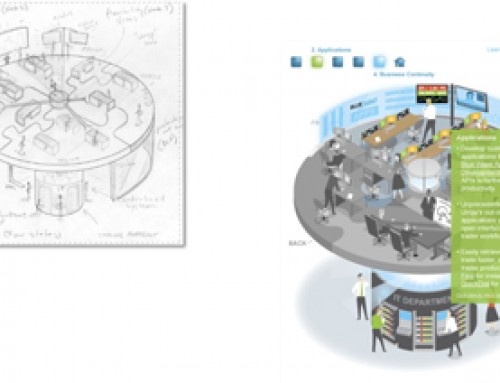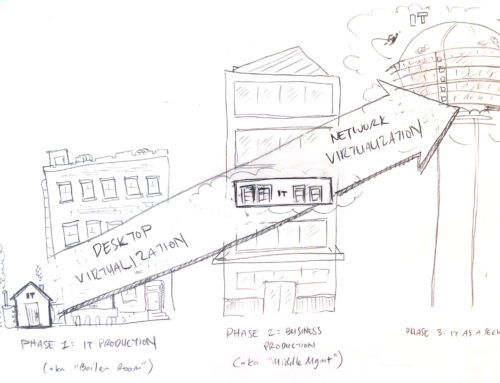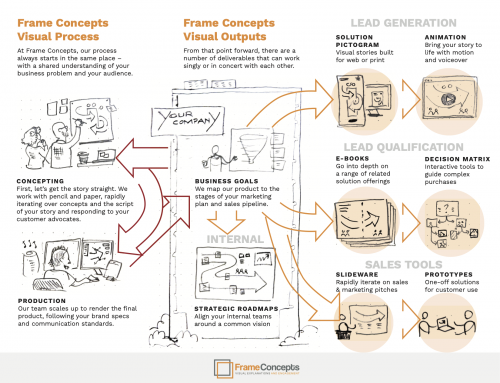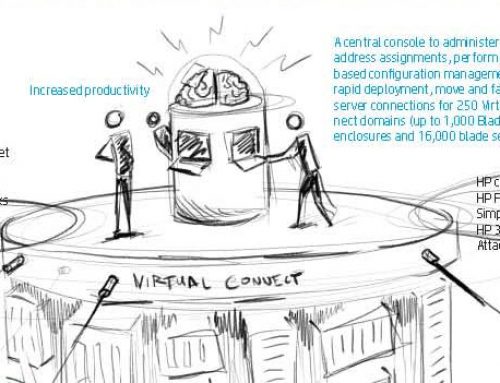It’s now tougher than ever to turn prospects into customers. But prospective buyers won’t make any moves unless they understand the full scope and magnitude of the challenges they currently face – and comprehend what a value-rich solution might look like.
These are complex matters requiring incisive and far-reaching explanations. The question is why we keep trying to describe and depict these matters in mere words.
How can we accelerate the buyer’s comprehension of complicated problems when we are failing to illustrate them in compelling ways? How can we expect our prospects to commit to high dollar, high stakes solutions when they can’t understand them – much less explain them to other members of their decision teams?
The Unprovoked Buyer
Prospective buyers are likely to remain indecisive – or worse, indifferent – if we fail to provoke them. If we don’t identify the issues that threaten performance – and clarify the case for a new approach – they will continue to embrace the status quo.Even those buyers out looking for a solution to an identified problem are unlikely to recognize value if that value is not vividly presented.
The unprovoked buyer is one who can’t clearly answer these questions:
- Does the scope and magnitude of the problem justify change?
- Does the financial impact of the solution justify investment?
- How will I get from the present state to the future state?
In a recent Harvard Business Review article making the case for “provocation-based selling,” Geoffrey Moore and his colleagues argue that sellers in today’s difficult markets must provide “a new angle on the situation” -clarifying issues that are unacknowledged or poorly understood.
In work with companies such as SAP, Microsoft and Accenture and a long line of entrepreneurial enterprises, my firm has demonstrated how compelling visuals can serve this purpose – provoking conversation and clarifying value. Visual provocation, as I’ve seen, can elegantly address the questions facing today’s unprovoked buyers.
The Case for Visual Provocation
Visual provocation is about exploring and explaining complex ideas with compelling images, dynamic animations and information-rich graphics. It certainly doesn’t eliminate the necessity to converse in words, but it makes our conversations so much richer and more insightful. Visual communication of this sort is also more memorable – and more easily conveyed to others who may not have been present during a prior conversation.
Instead of spending our precious meeting time trying to paint demanding word portraits and trying to synchronize our thoughts with those of our prospects, we can simply lay out a visual image that depicts the complex problem or solution we are trying to describe.
The visual image opens up discussion. It enables our prospects to see themselves in the problem space and visualize the dynamics that are at work. It is an enormously efficient means of producing clarity – or discovering hidden issues. It’s also a powerful way to help one’s prospects get a better sense of where they stand.
Lost in Translation
Imagine a company that sells complex solutions with a five- or six-figure price tag. It may be well acquainted with sales cycles running anywhere from nine to eighteen months. What happens when this company’s sales team shows up for a sales meeting with a prospect’s decision team?
If the company has diligently done its homework, the meeting will be based on insights gathered in prior conversations or analysis.
But what happens when the presenter starts showing slide after slide of bullet-pointed text that then leads to product-driven slides depicting technical architectures? What gets lost in translation? Why does the presentation fall short? And why doesn’t the deal go forward?
The problem is that prospective buyers can’t see themselves in the story – much less picture themselves as heroes of the story. It could be that there is no real story at all – just a long list of stuff that the “solution provider” can provide.
The Solution: Visual Provocations, Explanations and Demonstrations
Here’s a modest proposal. What if we start our positioning and messaging exercises – which lead to marketing content and sales presentation materials – by focusing on the visual representation of our buyer’s journey from the current state to the future state?
We can begin by sketching out a visual of what the prospect’s world presently looks like. My firm calls this the process breakdown or, more colorfully, Hell. We then go on to sketch out a picture of the process breakthrough or, more lyrically, Heaven. (Click on InfoGraphics for clearer definition.)
The goal is to produce a vivid depiction of the story in play. In fact, we are storyboarding the journey to be made – the hero’s journey if you will. By enabling the participants in a complex buying decision to see themselves in the story, we help accelerate their comprehension of the case for change and investment.
Of course, this approach lends itself to lots of compelling applications. As Dan Roam contends in his excellent book The Back of the Napkin, visual explanations “can help us crystallize ideas, think outside the box, and communicate in a way that other people simply ‘get.'”But consider the immediate payoff for sales and marketing specialists.
The Payoff: Becoming a Visual Provocateur
Indeed, several benefits emerge from the skillful use of visual provocations and explanations. The approach enables us to:
- Provoke Conversations. By vividly capturing the dynamics of a problem and the dimensions of a solution, we set the stage for engaging conversations exploring business value and the specifics of the customer’s world.
- Accelerate Comprehension. By clearly illustrating the scope, magnitude and cost of their problem, we help buyers comprehend why the present course may be unacceptable.
- Clarify the Case for Change. By clearly illustrating the solution and its dynamics, we illuminate a clear path from the present state to the future state – one that acknowledges the challenges of change and shows how it can be managed.
- Demonstrate Business Value. While some elements of the business case are best expressed in spreadsheet calculations, this approach also lets you visually tell the story of business value – showing, for instance, how costs will be reduced or revenue will be generated.
- Drive the Deal Forward. By building credibility and enhancing clarity, visual provocations and explanations provide a compelling map to guide buyers through the journey that lies ahead – giving them the confidence to invest and reducing the length of a decision cycle.
Ultimately, we have a powerful opportunity to engage buyers and drive growth by becoming visual provocateurs. By visually demonstrating the case for change, we build trust and credibility. We enable our buyers to leap the learning curve and see themselves as heroes in their own stories.
And while video, webinars and white papers are all powerful vehicles for presenting (and repurposing) compelling visuals, it may be in face-to-face sales meetings (or in sales conversations augmented with web conferencing) where this approach has its highest impact. This is the moment when we can put the buyer in a story that is uniquely his or her (or their) own. We visualize the unpleasant present to drive it into the past. We visualize the value-rich future to bring it into the present. We provoke to propel.
BRITTON MANASCO, June 25, 2010






